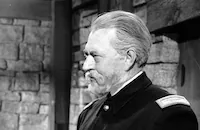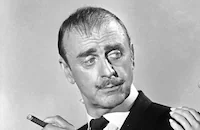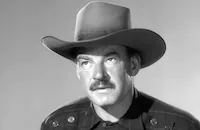Lorna Doone
Brief Synopsis
Cast & Crew
Phil Karlson
Barbara Hale
Richard Greene
Carl Benton Reid
William Bishop
Ron Randell
Film Details
Technical Specs

Synopsis
In 1673 in England, John Ridd writes the tale of Exmoor Valley, beginning years before: Sir Ensor Doone and his kinsmen govern the valley and its rich farmlands with firm hands and remain protected in their impenetrable castle. For their support of Oliver Cromwell's rebellion, King Charles II declares the Doones outlaws and orders their lands confiscated. Because Charles is occupied with a war with France, however, Ensor and his family are allowed to continue their ruthless control of the valley. The villagers, believing themselves free, are stunned when the Doones demand their usual quarterly fees. Farmer Ridd refuses to pay and is shot by the Doones. Young John Ridd is brought home from school to find his father dying and promises to continue the valley fight. When the sheriff takes no action against Ridd's murderers, John resolves to take matters into his own hands. Skirting the great falls and scaling the cliff on which Doone castle sits, John ends up on the castle grounds, where he collapses in exhaustion. He is discovered by young Lorna Doone, who tends to his cuts, until her cousins, Carver and Charleworth, arrive and thrash John for refusing to leave. Ensor breaks up the fight and is impressed when John demands that as a knight, Ensor is obligated to assist him in finding his father's murderer. Years later, as a young man just returned home after five years in service to the king, John finds himself still thinking of Lorna. When John's mother confides that the villagers meet secretly about the continuing Doone oppression, John decides to attend a meeting. As he urges the villagers to use extra money gathered from a bountiful crop to purchase arms, Carver and Charleworth ride up and order John publicly whipped for instigating insurrection. Lorna, waiting in a nearby coach, reduces John's punishment. Later, John again rallies the villagers to attack the Doone militia for their arms. Soon after, John is held up by a masked bandit, who turns out to be his cousin, Tom Faggus. Tom cheerfully agrees to help battle the Doones and quickly rounds up a stash of weapons. One day when Carver and his guards ride out to inspect the lands, John claims some militia attire and, disguising himself in it, climbs the cliff to return to the Doone grounds. He meets Lorna and is dismayed when she reveals she is betrothed to Carver. Returning to the village, John plots to take eight men with him up the cliff to capture the crucial drawbridge and allow the villagers into Doone castle. Suspicious of the men's absence, Carver rounds up their families. Ensor, bedridden, demands that Carver refrain from harsh measures, but backed by Charleworth, Carver refuses. In desperation, Ensor confesses to Lorna that she is not his granddaughter, but was taken hostage as a child from his most bitter enemy at court, the Duke of Lorne, cousin to the king. Carver knows the truth and harbors hope that their marriage will bring about the king's forgiveness. Before dying, Ensor writes a confession halting the wedding. Although she is being held on the grounds on Carver's order, Lorna sends a message to John seeking a meeting at the top of the cliff. There, she shows him Ensor's letter and guarantees the duke's assistance against the Doones. John's men consider the ploy a trap, and when Carver intervenes and John and Tom escape with Ensor's letter, the men believe they have been betrayed. John finds the duke with the king and persuades them to help Exmoor. As John hurries back with the king's guard, Carver arranges his wedding to Lorna. John breaks into Doone castle just before the ceremony and captures all the Doones except Carver and Charleworth, who hide in a room below the castle. Carver watches in a mounting rage as King Charles arrives, knights John and awards him the castle. As John and Lorna are about to wed, Carver comes out of hiding and shoots Lorna, then he and Charleworth are killed fighting John. Lorna recovers from her wound, and she and John take up living in Doone castle in the now-free Exmoor Valley.

Director

Phil Karlson
Cast

Barbara Hale

Richard Greene

Carl Benton Reid
William Bishop

Ron Randell
Sean Mcclory

Onslow Stevens
Lester Matthews

John Dehner

Gloria Petroff
Orley Lindgren
Dick Curtis
Anne Howard
Katharine Warren
Malcolm Keen

Queenie Leonard
Trevor Bardette
Myron Healey
Harry Lauter
Norman Rainey
Tudor Owen
Trevor Ward
Betty Fairfax
Allen Pinson
Ted Jordan
Glenn Thompson
Bruce Lester

Leonard Mudie

Ray Teal
Fred Graham
Paul Collins
Jerry Mickelsen
Gerald Hamer
Eric Wilton
Sherry Jackson
James Logan
Pat Aherne
Wheaton Chambers
House Peters Jr.
Bill Hale
Crew
George Bruce
Lawrence W. Butler
Clay Campbell
Al Clark
James Crowe
Francis Cugat
George Duning
Frank Goodwin
Helen Hunt
Jesse L. Lasky Jr.
Jean Louis
Harold Macarthur
Richard Mayberry
Richard Schayer
Edward Small
Morris Stoloff
Charles Van Enger
Grant Whytock

Film Details
Technical Specs

Articles
Sean McClory (1924-2003)
Born on March 8, 1924 in Dublin, Ireland, he became a leading man at the famous Abbey Theatre in the early '40s and relocated to the United States shortly after World War II. His first roles were small bits as a police officer in two RKO quickies: Dick Tracy's Dilemma and Dick Tracy Meets Gruesome (both 1947). He eventually graduated to more prestigious pictures like The Glass Menagerie (1950), Les Miserables (1952) and John Ford's The Quiet Man (1952).
After a few more supporting roles in quality pictures: Niagara (1953); the sci-fi chiller Them! (1954); and for John Ford again in The Long Gay Line (1955), McClory turned to television. He kept busy for several years with guest roles in a variety of popular shows: Bonanza, Wagon Train, Rawhide, Gunsmoke, The Outer Limits (1964) and countless others. By the mid-'60s, McClory became slightly more heavy-set, and began tossing off variations of jovial, "oirish" blarney for, yet again John Ford in Cheyenne Autumn (1964); and in a string of Disney pictures: Follow Me, Boys! (1966, his best role, a moving performance as the alcoholic father whose behavior alienates his son, played by a 15-year old Kurt Russell); The Happiest Millionaire (1967), and The Gnome-Mobile (1967), before he returned to television. His final role was in John Huston's acclaimed Irish opus The Dead (1987). He is survived by his wife, Peggy Webber McClory.
by Michael T. Toole

Sean McClory (1924-2003)
Quotes
Trivia
Notes
After the film's opening credits, actor Richard Greene provides a brief voice-over commentary as his character, "John Ridd."Daily Variety, Hollywood Reporter and Los Angeles Times news items indicated that producer Edward Small initially intended to film Lorna Doone on location in England, using frozen funds. Hollywood Reporter asserted that Small had registered the film's title in the U.S., but that producer Sidney Bernstein had registered it in England. News items noted that Small's associate producer, Grant Whytock, and art director Rudy Sternad were traveling to England to scout locations. The film was shot entirely in Hollywood, however, and any further participation by Sternad has not been confirmed. No evidence of Bernstein's British production has been found.
According to Los Angeles Times, writer George Bruce was borrowed from M-G-M to adapt the Richard Doddridge Blackmore novel. Other Hollywood Reporter items disclosed that actor Farley Granger was suspended by Samuel Goldwyn for refusing to be loaned out to Columbia for the role of "John Ridd." A contemporary source indicated that actor Glenn Langan was considered for a role in the film, but he was not in the released film.
Among the many other filmed versions of Blackmore's novel are a 1911 Thanhouser production, directed by Theodore Marsten, starring Frank Crane and Margaret Snow; a 1915 Biograph production, directed by J. Farrell MacDonald, starring Vola Smith and Edward Cecil; a 1922 Thomas H. Ince Corp. production, directed by Maurice Tourneur, starring Madge Bellamy and John Bowers (see AFI Catalog of Feature Films 1921-30) and a 1935 British production, directed by Basil Dean, starring John Loder and Margaret Lockwood. In 1990, another version was produced for British television.














